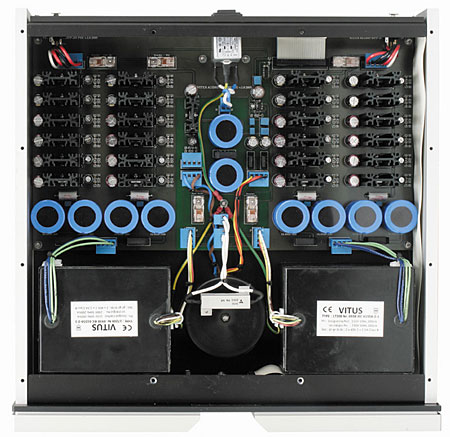| Columns Retired Columns & Blogs |
Vitus Audio MP-P201 Masterpiece Series phono preamplifier
This massive, two-box beauty from Denmark costs $60,000, and I wish I could tell you it wasn't really better in most ways than the already outlandishly priced and sonically superb Boulder 2008. I can't.

No one spends this kind of money on a phono preamp unless its appearance and functionality are commensurate with its sound, and in the MP-P201 they are—even if there's only the RIAA curve, and no Mono button. However, what will get wealthy enthusiasts to drain $60k from their bank accounts will be the Vitus's unmistakably astonishing sound. Plug it in, play it, and compare it with whatever you own, and unless you are a confirmed tubeaholic, if you've got the krone, prepare to shell out. Designer Hans-Ole Vitus claims that this method has already sold more than a few units of his mundanely named product.
The Vitus includes switchable, independently configurable balanced and single-ended inputs and a single balanced output. Pushbuttons select and save input sensitivity (125–500µV for MC) and loading for each input, the name of which can be selected from a list of 10 popular cartridge brands—or, in Text mode, you can enter your own.
Vitus offers a choice of four dealer-installed modules for resistive loading, only one of which can be installed at a time. Each includes 16 different resistances,. Two are MC only, and two offer both low impedance loading and 47k ohms, for those who have MC and MM cartridges. No alternate capacitive loadings are offered, but really—how many buyers will use an MM cartridge with a $60,000 phono preamp?
Oh, no!
In direct comparisons with the Boulder 2008, the Vitus MP-P201 produced more of everything that anyone would want to hear from a solid-state phono preamp—and for twice the price but with considerably less functionality, it had better well! The first late evening I spent with it had me yelling, loudly and often, to no one in particular, "Are you f***ing kidding me?"

Just when I thought the dynamic and spatial potentials of an LP had been fully expressed, just when I thought the resolution of inner detail of the other top contenders I've heard had revealed all that was engraved in the grooves of some overly familiar vinyl, the Vitus proved me so wrong. Even casual listeners—such as my skeptical next-door neighbor, who visits periodically to hear the latest insanity—exclaimed profanely when he heard his requests through the Vitus.
Often, great amplifiers are described as "gripping" and "holding" the loudspeakers. The Vitus MP-P201 did that to the signal coming from the cartridge as no other phono preamp has in my experience. That effect rippled through the signal chain, improving the performance of everything it touched, and finally tightening its grip on the speakers themselves. It wasn't at all subtle—as a visiting speaker manufacturer heard the other day. Nor did it sound too mechanical or dry or "electronic"—though again, if you primarily value the continuousness and flow of tubes, while you'll be respectful of what the MP-P201 achieves, you might not be as impressed as I was.
The MP-P201's dynamic presentation at both ends of the scale was nothing short of ridiculous. Its bass extension, control, and weight were granitic. Its ability to tonally and spatially retrieve and resolve instruments and voices within a narrow frequency band produced a constant barrage of new information from some very familiar recordings.
Unexpected voices and instruments appeared in three-dimensional space from the most familiar recordings. These familiar recordings are almost part of my DNA, so suddenly hearing something completely new and obvious produced many "WTF" moments. Even after having sat mesmerized by that Shostakovich LP through both Boulders, hearing it now through the Vitus MP-P201 was yet another revelation of what's possible from vinyl playback specifically, and from musical reproduction in the home in general. The Vitus drew a line in the sand of its soundstage that produced images of the fronts of orchestras way back in space, with an unprecedented solidity and certainty of location. Every aspect of the spatial picture was equally solid and convincing, including the front-to-back layering of orchestral sections—even though this Melodiya/EMI is a very distant recording.
Nor did such a degree of delineation sound artificial. It sounded as natural as when I hear the New York Philharmonic in Avery Fisher Hall, with imaging, soundstaging, and depth just as easily audible—not as compartmentalized musical workstations, but as part of an organic whole that some skeptics claim doesn't exist when you hear symphonic music live. It does.

The Vitus MP-P201's speed, transparency, three-dimensionality, frequency extension, rhythmic ability, musical grip, and any other parameter you could name—with the exception of what only tubes can do—took the overall sound to a new, exalted level. That Shostakovich performance sounded as convincingly "live" as I've ever heard from a recording—except through the Ypsilon VPS-100 tubed phono preamp ($27,700), which I reviewed in my August 2009 column.
If you can look yourself in the eye and spend $60,000 on a phono preamp, you need to hear Vitus Audio's MP-P201. You need to hear it even if you haven't got the $60k—just so you know what awaits you, should you strike it rich.
- Log in or register to post comments




































